GM's CEO Dan Akerson made a pair of appearances in San Francisco last week in which he made a strong case for the Chevy Volt, improved fuel efficiency, as well as the government playing a role in shaping industry. His comments come amid a swirling politicized controversy surrounding General Motors, the Chevy Volt, global warming, automakers efforts to reduce environmental impact, and the automobile industry bailout. Akerson made it clear that the "new GM" (as he called it) was intent on being part of the solution, rather than being obstreperous, and to that end that GM is exploring every alternative to gasoline, every fuel efficiency technology, and will continue developing vehicles like the Volt.
Clearly Akerson's answer to the question "Should GM kill the Chevy Volt, stand pat, or create the Volt2?" is not only to build the Volt 2.0, but he described it during an interview with the Climate One program of The Commonwealth Club.
GM's Dave Barthmuss reported, on thefutureiselectric.com, about a lunch-time meeting between Akerson and a group of 30 Chevy Volt enthusiasts to talk about GM's commitment to a sustainable future. Akerson, a Volt owner himself, talked of having burnt only 1/10th of a gallon of gasoline since February, and that among the Volt owners in the meeting one had driven nearly 13,000 miles on the initial tank of gasoline sold with his Volt.
The interview with Climate One host Greg Dalton was an hour of wide ranging and frank discussion about GM, the auto industry bailout, fuel efficiency, the Volt, and much more.
Akerson described the New GM as a company that can no longer be internally focused, that GM must focus on the evolution of the automobile industry, to look forward to see where the market conditions are going, to position GM correctly in the future, especially in regards to meet expected future environmental, fuel efficiency and fuel flexibility standards. As he put it GM "can't afford to focus on the near term" but must ask "What will market conditions be like in 2030?" In saying this it's as if Akerson's take on GM's bankruptcy is that GM wasn't focused on the actual direction the market was taking, but on attempting to manipulate the market forces in a way that ultimately led to GM's bankruptcy.
Speaking on the auto industry bailout, Akerson comes across as a big champion of that process. His former position was "Head of Global Buyout" at the Carlyle Group, making him well suited to critique the U.S. Government's role in the auto industry bailout. He noted there are "multiple options or avenues to a successful restructuring" of any troubled corporation, and that, in his opinion, as someone who had a front row seat, was that "it was coming off the wheels," meaning that GM was about to disappear completely. The cost if GM were to have failed would have been 1 million jobs, $150 billion in lost taxes, and deep damage to America's industrial infrastructure. The old adage "What's good for GM is good for America" comes to mind, but clearly Akerson's opinion is that, in the context of the deep recession of 2008-9, that another 1 million lost jobs would have turned the recession into a full scale depression.
Akerson noted that two Presidents (Bush and Obama) "put money into this company" (GM) and that neither "were running for office at the time." This fact flies in the face of the political spin machine that's trying to pin the bailout solely on Obama's shoulders, when in truth it was a bipartisan effort. That the leadership in that time "made the pragmatic decision to save this company" rather than take the cost just outlined. For that matter, is the bailout a failure as the spin machine might have us believe, or is it a success? By Akerson's reckoning, it is not only a success, but Americans "ought to be very proud our government stood up regardless of party affiliation" to do the bailout.
What about the "Government Motors" aspect to the company, the fact that the Federal Government directly owns a large chunk of GM. First, Akerson noted that GM has already paid back the government loans, as well as paid back the Preferred stock owned by the government. GM's IPO was the largest IPO in the history of modern finance, and a large chunk of those shares went to the Federal Government, leaving the U.S. owning 27% of GM "on a fully diluted basis". Akerson describes the Government as if it were any other share-holder, and the Government could sell those shares any time it likes, but that it has not done so. However, if the Government were to sell its holding that would depress GM's stock price. Instead of selling these shares all in one chunk, Akerson suggested the Government begin a timed sale of these shares over a 10 year period.
Akerson asked these questions: "Is the federal government a private equity firm? Or was it acting on behalf of we the people? Was our economy, was our citizenship, properly served?" He then went on to say "governments help their companies to, without too much of a heavy hand, shape and mold the direction of technology and how the economy evolves," and that "it's something that is pragmatic" and that it's "done for companies around the globe all the time." A moment of pondering this and we recall that governments make regulations, governments set policies, that governments often form "public private partnerships" to achieve certain goals, that governments have made grants or loans to companies a zillion times over the years, and that this has gone on for decades. For example the whole of the computer & technology industry (and the Internet) was goosed into being through a wide range of government support over the decades, often for technology developed originally for military use and then repurposed for consumer electronics gizmos. The Internet began its life as a Department of Defense project to connect military command and research institutions, and that if the Government had not funded the Internet's initial development it simply would not have existed in the form it takes today, if at all.
All through the interview Akerson glowingly described GM's efforts to decrease the environmental impact of its operations, and the vehicles the company sells. For example most of GM's plants have drastically reduced energy consumption, several are now powered by methane coming from landfill gas, and GM has almost completely eliminated the waste sent to landfills. What's even more interesting is the efforts GM is making to build cleaner vehicles.
Why? The purpose is two-fold, first to decrease the environmental impact of the vehicle fleet, and second to transition away from fossil fuels. Again, the New GM, in Akerson's mind, acts proactively to be part of the solution rather than to be an obstreperous obstruction. GM was a willing participant in the CAFE standards currently being proposed. He noted that due to the EPA, "the air and water is cleaner today than it was in the 50's and 60's" and it's Akerson's belief that "it ought to be even cleaner tomorrow than it is today."
Interestingly GM has developed a new engine, announced last week, that can run on either gasoline or Compressed Natural Gas (CNG). It took some work on lifters and carburetors and whatnot, the cost is a bit more than the pure gasoline counterpart, but not prohibitively so, and such an engine clearly positions GM to sell CNG vehicles in the not-to-distant future.
One of GM's operations is GM Ventures, a fund that invests in promising companies developing technology that could be useful to GM. Akerson used one of those investments, Envia Systems, to describe what could be thought of as the Volt 2.0. That company has developed battery technology claimed to drastically reduce the cost of lithium ion batteries, and to drastically increase the energy density. Currently the Chevy Volt has a 400 pound battery pack, 16 kilowatt-hours, that can drive the Volt for 35-40 miles on electricity alone. Akerson variously described an Envia-powered Volt has having a 140 or 240 mile range and that "battery technology will improve over the next 5, 10, or 15 years".
However, as Climate One host Greg Dalton noted, many are calling the Volt a failure, the most recent example is the five week Chevy Volt production halt. Akerson noted that "you never have perfect knowledge of what the market is going to do" and that any automaker is going to "match production with inventory." Even the Chevy Cruze, one of the top selling cars in America, had a two week production halt last fall. A production halt that nobody noticed, whereas because of the intense politicization of the Chevy Volt everybody knows about its production halt.
Why is the Chevy Volt good for America? Akerson answered “the Volt represents American innovation, American ingenuity…the best of this country and the best from this company.”
Image Source: General Motors Western Region Flickr page


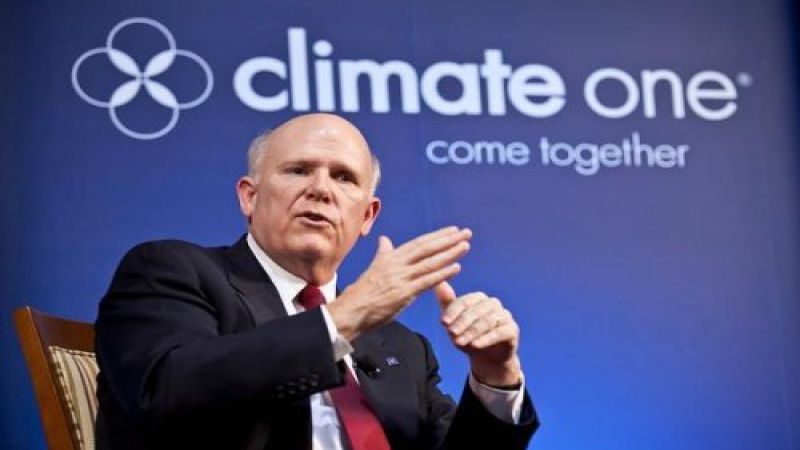




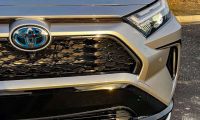
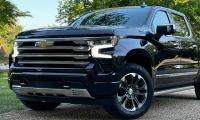
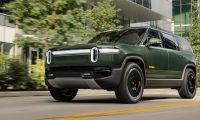
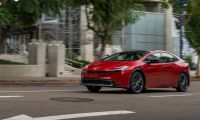

Comments
Meanwhile the Energy
Permalink
Meanwhile the Energy Information Administration just released their summary data for electricity generation for 2011. It showed a 0.5% overall reduction in electricity consumption, a 7% (!!) reduction in coal use taking coal below 40% of total electricity generation for the first time in over 30 years. Meanwhile there was a 26% rise in hydroelectric production, 25% wind increase and a 50% increase in solar energy production. The grid is rapidly undergoing a transformation towards clean green low carbon energy, a transition to electric vehicles wil position America as world leaders in pollution and greenhouse gas emission reduction
That's all fine and good but
Permalink
In reply to Meanwhile the Energy by Rob (not verified)
That's all fine and good but it doesn't really matter as this same grid produces the 5 - 7 kwh of energy needed to get a gallon of gas from the ground refined and into a cars gas tank. The volt can go further at that energy than an average car can go on that gallon of gas.
It's about efficiency , and nothing beats electric drive in this department, not NG, not ethanol , nothing....
I completely agree that gas
Permalink
In reply to That's all fine and good but by Mark (not verified)
I completely agree that gas cars probably use around the same amount of electricity per mile as electric cars because the refining industry is a voracious consumer of electricity. I don't agree that means that we shouldn't care where the power comes from for EVs. It's a lot easier to explain a 20% reduction in coal and a 50% increase in renewables contribution over the last 8 years on the grid then it is to convince the average gas car driver that their gas car uses as much electricity as an electric car.
Do you know of a canonical
Permalink
In reply to That's all fine and good but by Mark (not verified)
Do you know of a canonical source for this figure? I have seen various calculations of the kilowatts used to refine gasoline, and the results are all over the map. Summary: http://greentransportation.info/how-much-electricity-is-used-refine-a-gallon-of-gasoline
The reason this is important however is that if the electricity used to refine gasoline were repurposed for driving cars, we'd be able to drive a full electric car fleet off that electricity. Right? There are a lot of "if"'s but that's a compelling argument.
The reality is its very hard
Permalink
In reply to Do you know of a canonical by David Herron
The reality is its very hard to say accurately, that's partly because it varies, also many refineries have their own gas cogeneration plants rather than using grid power. Suffice it to say however that refineries are gargantuan power users, whether or not you could completely run on an electric fleet on the power displaced by idling refineries is debatable but it would come close. Even if it doesn't fully cover it any increase in power demand will be much much smaller than people expect at the very least. I agree though about the significance, can you imagine if it turns out that electric cars actually reduce electricity demand?
"26% rise" and "25%" increase
Permalink
In reply to Meanwhile the Energy by Rob (not verified)
"26% rise" and "25%" increase mean nothing since those two combined (hydro and wind, plus all other alternatives if you want to throw in solar and whatnot) make up less than 5% of our total national power map.
The reason for coal's decrease wasn't because it's being replaced by renewables (which your list of data implies), but because natural gas prices dropped to a very low point early in 2011 and stayed there (they're still low now). You left out the amount of NG-based power production increase, which from January 2011 to December 2011 jumped about 8.5% to make up about 1/3 (roughly 33%) of our nation's total power production.
NG is better than coal, but don't assume that because solar and wind jumped by huge percentages (which are only statistics, since they made up such a tiny fraction) that those are the source of coals "demise" here. Wind and solar have inherent problems that will limit them to being only a small fraction of our total grid.
Actually they made up 12.6%
Permalink
In reply to "26% rise" and "25%" increase by Aaron Turpen
Actually they made up 12.6% of the national electric grid in 2011. I'm not saying there aren't obstacles with renewables and I wasn't trying to hide NG increases.
Between 2010 and 2011 renewables increased from 427,380 thousand Mwh to 520,067 thousand Mwh, an increase of 92,687 thousand Mwh, natural gas increased by 28,898 thousand megawatt hours, meanwhile coal generation fell by 113,025 thousand megawatt hours. This isn't opinion this is hard fact the majority of the reduction in coal use was offset with renewables not natural gas, in absolute numbers not just percentages.
Renewables are reaching a tipping point and are not the insignificant contributors they were a few years ago.
All of this data is available in the EIA's February Electricity Power Monthly.
OK, I see the press release
Permalink
In reply to Actually they made up 12.6% by Rob (not verified)
OK, I see the press release you're basing your numbers from. That's 2009-2011 numbers you're referencing.
"Total electricity generation was down 7% in December 2011 compared to December 2010 (see chart below). Despite this decline, generation from natural gas rose 12% to 86 terawatthours. Coal-fired generation, however, fell by 21% between December 2010 and December 2011, to 132 terawatthours."
I see the chart you're using.
1.73Cmwh coal, 1.02Cmwh for NG, 0.79Cmwh for nuclear (down from 2010 by about .16), 0.325Cmwh for hydroelectric, 0.195Cmwh "other".
"Electric Power Monthly - Net Generation by Energy Source: Total (All Sectors), 1997 through December 2011 (using 2010 and 2011 lines).
Close, I'm referencing table
Permalink
In reply to OK, I see the press release by Aaron Turpen
Close, I'm referencing table Table ES1.B. Total Electric Power Industry Summary Statistics, Year-to-Date 2011 and 2010.
In the February edition of the EIA Electric Power Monthly. Its the second table of the whole report. It teases out that change over the last 12 months in a little more detail. What it shows is that the increase in renewables in 2011 in absolute power output terms was about 3.2 times higher than the increase for the year in natural gas generation. It shows total renewables reached 12.6% for the year, that's not capacity that's actual generation, a growth of over 20%. It showed natural gas contributed a little under 25% of the annual electricity production, with a yearly growth of 2.5%. Renewables are becoming a major player and continue to grow at many times the rate of all other energy generation capacity, whilst coal and petroleum products are shrinking in their generation contribution between 6 and 30% annually.
The data is supposedly for
Permalink
In reply to Close, I'm referencing table by Rob (not verified)
The data is supposedly for the same time period, yet the data I see and the data you're referencing don't jibe. ?
Yes they do, it shows hydro
Permalink
In reply to The data is supposedly for by Aaron Turpen
Yes they do, it shows hydro plus other renewables about 0.5 CMwh, natural Gas 1.02 CMWH, Coal 1.7 CMWh, total of 4.1 CmWH. With Coal shrinking, Natural gas growing slowly, renewables growing at nine times the rate of natural gas and total demand slightly shrinking.
The only thing that doesn't mesh is some of the numbers in your first post which you never provided any basis for, renewables being almost three times lower than the EIA says, natural gas providing greater than 1/3 of our power when it is actually less than 1/5 and natural gas providing all the offset for coal's fall when in actuality renewables rose by more than three times as many CMWh as natural gas for the year. Do you now repeal those claims or do you have a reference?
Those numbers are based on
Permalink
In reply to Yes they do, it shows hydro by Rob (not verified)
Those numbers are based on the best that I knew at that time, before seeing this latest from EIA. They're from 2006, I believe.
So you were rebutting a post
Permalink
In reply to Those numbers are based on by Aaron Turpen
So you were rebutting a post specifically discussing 2011 data with 6 year old data from 2006, which you were purely taking from memory, seriously?
Sorry but it just seems blatantly ludicrous to essentially accuse someone of lying "The reason for coal's decrease wasn't because it's being replaced by renewables (which your list of data implies)," using 6 year old data that doesn't even vaguely relate to my original post.
Your data was claimed as 2011
Permalink
In reply to So you were rebutting a post by Rob (not verified)
Your data was claimed as 2011 and referenced from IEA (which often PROJECTS data). So I assumed it was based on their latest press release, which talks about PROJECTED ENERGY USE. I then took some data from memory and the latest data available from sources other than the IEA (since I didn't know they had 2011 data). That being the 2008 OECD numbers released in 2009, which I wrongly labeled as 2006 above.
After I've accepted your data and points, you then turn and call me ignorant. Thanks. I'd rather be ignorant than be an ass. At least you can fix ignorant.
Maybe my backs up because you
Permalink
In reply to Your data was claimed as 2011 by Aaron Turpen
Maybe my backs up because you started off by calling me ignorant and a fabricator. Frankly I struggle to see where you accept my points, you acknowledge the report then continued to dispute the data from it.
Once I acknowledged your
Permalink
In reply to Maybe my backs up because you by Rob (not verified)
Once I acknowledged your data, I questioned it because the same source gave slightly different data. By acknowledging your data, I was accepting that it existed, which would remove my earlier data as being outdated (as stated). Until then, the only data I'd seen were those I've given: data from 2008 and a Nov-Dec 2011 list.
To bring this thread back to
Permalink
To bring this thread back to something constructive, the volt battery is unique because it is engineered to take both capacity fade and "accidental bricking" out of the picture. It does this with a 6 kwh buffer. This is why you only see 10 kwh from the 16 kwh battery before the gas kicks in. This gives it a solid advantage in lifespan and unlike the leaf, tesla and the soon to be released comp from BMW and the like, the volts system is idiot proof.
You can park the volt, battery drained, at the airport in Pittsburg in February , Come back a month later and it's still great... GM has done an amazing engineering job, which is why it is winning awards...
Now it's up to the salesmen to convince your average middle class commuter that the volt is really worth the money....
Exactly.
Permalink
In reply to To bring this thread back to by Mark (not verified)
Exactly.
Teslas and leafs have similar
Permalink
In reply to Exactly. by Aaron Turpen
Teslas and leafs have similar buffers, Tesla has a 5% buffer. Its a tradeoff, how much of the expensive battery pack are you willing to lug around as dead weight in order to idiot proof the thing. Do you punish the people who care for their vehicle properly by locking up half the battery pack to protect a few idiots who cant read a manual? Theres no easy answer, but they do all have battery protections built in, all the volt has done is made it an enormous percentage of the packs capacity. The Tesla bricking blog controversy came about in a very early Roadster before some of the battery protection features were added, I believe only the first 400 cars are more susceptible to battery issues due to fewer protective features.